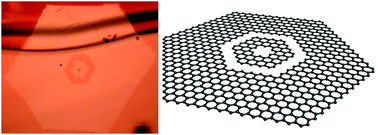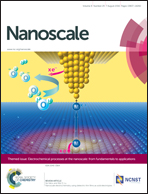Double hexagonal graphene ring synthesized using a growth-etching method
Abstract
Precisely controlling the layer number, stacking order, edge configuration, shape and structure of graphene is extremely challenging but highly desirable in scientific research. In this report, a new concept named the growth-etching method has been explored to synthesize a graphene ring using the chemical vapor deposition process. The graphene ring is a hexagonal structure, which contains a hexagonal exterior edge and a hexagonal hole in the centre region. The most important concept introduced here is that the oxide nanoparticle derived from annealing is found to play a dual role. Firstly, it acts as a nucleation site to grow the hexagonal graphene domain and then it works as a defect for etching to form a hole. The evolution process of the graphene ring with the etching time was carefully studied. In addition, a double hexagonal graphene ring was successfully synthesized for the first time by repeating the growth-etching process, which not only confirms the validity and repeatability of the method developed here but may also be further extended to grow unique graphene nanostructures with three, four, or even tens of graphene rings. Finally, a schematic model was drawn to illustrate how the double hexagonal graphene ring is generated and propagated. The results shown here may provide valuable guidance for the design and growth of unique nanostructures of graphene and other two-dimensional materials.



 Please wait while we load your content...
Please wait while we load your content...